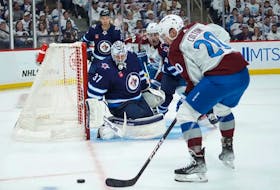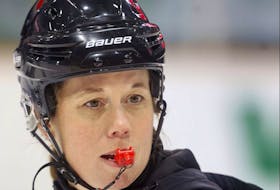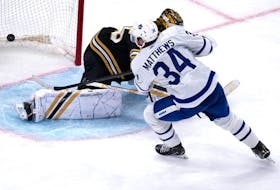For some, it is an art.
The whole process is a regimented part of the day and daily routine at the rink; it can be a product of who they admired, who they studied on TV, whose posters were draped all over their bedrooms.
It could be a process ingrained in them since they started skating, since their parents whipped a roll around their stick a couple of times, shoved it into their hands and pushed them on the ice.
The similarities, the differences, the simple or the intricate, each member of the Calgary Flames and their stick-taping habits tell a story.
“I’m very, very boring,” said Matthew Tkachuk. “On the top of my stick, I do five loops around the top. And then just a couple down. Then on the bottom, I go heel to toe and all the way to the toe and scissor it, and put wax on it.
“I’m probably one of the few that doesn’t spend too much time on it.”
Sure. That’s what they all say.
The truth is, the Goldilocks effect applies to many when it comes to taping sticks. And, at hockey’s highest level, it’s understandable players prefer things done a certain way — there’s no time limit for something as important as their stick, their basic tool that makes them millions and millions of dollars each season.
Many, like Tkachuk, are self-aware. Speedy and not too picky.
Others are meticulous. They know their way is a bit quirky, a little bit particular, but it’s just how they like it.
“Everybody’s different, for sure,” the Flames’ longtime equipment manager Mark DePasquale was saying in his “office” the other day, the space adjacent to the players’ dressing room which is lined with equipment, tools, and, yes, rolls and rolls of stick tape.
“Now, it can be anything. The way you grew up or what you watched. There are guys with skinny knobs. Thick knobs. White tape. Black tape. Used to be a lot of friction tape — sticky tape — but I haven’t seen that in years. You used to see shooters have bigger knobs and stick handlers have skinny knobs. But it’s changed over, and over.”
Some things, however, haven’t changed and the basics remain the same — a stick and stick tape.
The National Hockey League works with equipment companies like Mission, CCM, Bauer and Sherwood and teams receive a stick budget per year. As a rule, DePasquale budgets a stick per game, per player.
At any point, players will have three or four sticks ready to go during a game or practice, so the team’s equipment staff can easily toss them a new, freshly taped one at a moment’s notice.
But on occasion, DePasquale, assistant equipment manager Corey Osmak or equipment manager assistant Ben Dumaine will have to step in and help.
“If a guy breaks a stick, we’ll try to match (the tape job),” DePasquale said. “We’re pretty good at it …”
Although he does remember taping Jarome Iginla’s stick once — in a pinch — and, apparently, it was incorrectly.
“I did one too many wraps on the heel and the next day as a joke, he taped it all the way up the stick and goes, ‘Here’s your tape job,’” DePasquale said with a laugh. “I’m like, ‘Sorry Jarome, next time you’ll have to do it yourself.’
“It’s comical, sometimes.”
And so much to remember. Like, the colour combinations.
Some have white tape on the top and the bottom.
Black on top and the bottom.
White on the bottom and black on top.
White on top and black on the bottom.
Then, there’s the direction they tape the blade.
Heel to toe? Toe to heel? Inside to out? Outside in?
“Just basic, heel to toe,” said Mark Giordano, who uses black on the top and bottom. “I’m a guy who likes covering the toe though so I have to tape past the toe and then cut with the scissors around it. I like taping my stick every intermission because I hate when there’s a rip or a cut through it during the game.
“I don’t use wax, I feel like the puck slides too much. I’m not too particular but I just like fresh tape every period.”
Derek Ryan is low-maintenance.
“I start at the middle of the blade and go to the toe, a little bit of wax on there, that’s it,” he added. “But it always starts with what your Dad does. I don’t really care about it. To me, it’s more of a chore. I wish it would just be there permanently and not get scuffed up and I wouldn’t have to deal with it.”
Some tape it once, in the morning before a game or practice, and forget about it. There are the players who will only fix the tape job if it’s massively ruined or if there is a giant hole.
Then, there are the ones — like Giordano — who prefer it fresh.
Before morning skate, after morning skate, before the game, after each period, and after the game.
“Because if I tape it after the third period, I don’t have to tape it for the next practice,” defenceman Rasmus Andersson chimes in. “Obviously, if someone steps on it, I’ll need to switch and I’ll tape it in practice.”
Sometimes, it’s just out of habit.
Or boredom.
“We’re in the dressing room for 18 minutes (between periods),” said forward Dillon Dube. “So, I’m just sitting there. It keeps mind off the game and I’m not overthinking. It’s just a habit of always doing it and it’s nice to have a clean job. It’s pretty simple — not complicated. It takes me 10 seconds to do and if there are creases, it doesn’t really bother me. I go from the closest I can to the toe without using scissors to the heel. I don’t like taking time on it.”
Michael Stone is the same.
“It’s just what I do — I’m not superstitious at all, it’s just what I’ve always done,” said the blueliner. “It doesn’t matter if it has a cut or it’s worn or stepped on or not, it’s just what I do: tape my stick between every period.”
(And black, only, “because that’s what my dad bought me and my brother (Mark).”)
Then, there are some who simply couldn’t be bothered.
Johnny Gaudreau is, likely, the fastest at taping his stick on the team. Toe to heel. Beat up tape.
Superstitious?
“No, no, that’s not me at all,” Gaudreau said with a chuckle. “I just tape it and go out and play. Sometimes I’ll tape it before games. Sometimes I’ll not tape it before games. If I have enough time in my stall. I don’t really take much time with my sticks.”
There’s the other side of the spectrum.
DePasquale wouldn’t name names, but said there are players that, if it’s not done absolutely correct the first time, they will rip the entire tape job off and start again.
Andersson could be one of those players.
“It’s one of those things — I’ve never been too picky about it but it needs to be perfect for me,” the Flames defenceman admits.
Michael Frolik, one of the most particular players on the team about his equipment, could fall into that category too, although he admits he spends “10 minutes, max,” on his stick.
He says his tape job is “pretty simple.”
“I always use black tape,” explains the veteran winger. “I leave the heel of it open, and then I go from the open heel to the top. That’s it. I’ll take my time. It needs to be kind of perfect, for me. I don’t tape sticks during the games. I just tape it once — other guys, I think, I’m think maybe the only one that doesn’t tape them during the game after every period.
“I just do it once before the game then I just leave it. I’ll do one and one pretty slow and make sure it’s right.”
And there are some players who have been around so long that they can recite exactly what they do, when they do it, why they do it, and all of the reasoning in between.
“My first year (in the NHL), playing with Marc Savard, he was probably the most superstitious when it came to taping his stick,” pointed out Milan Lucic, who played with Savard in Boston. “Every line had to be, like, perfect. And he liked the white to be the perfect distance apart from each other and he taped his toe. The way he did his knob … it had to be perfect in order for him to use it.
“If he didn’t like it one shift, he’d be done with the stick and move on with it.”
Lucic, a 31-year-old veteran of 927 NHL games, says his preference is “nothing crazy.” Heel-to-toe, but not all the way over the toe — a “toe tuck,” as DePasquale calls it. White tape. Regular knob.
“Nothing, really, to it,” Lucic says.
Then, there’s Andrew Mangiapane — the opposite of that.
Mark Jankowski confirms this.
“Mangy is particular, he takes a long time,” Jankowski said. “It’s kind of funny.”
Added Andersson, his former Barrie Colts teammates: “He needs to have 26 stripes on it. He sits there and counts, every time. Otherwise he can’t score.”
Scissors, of course, make things easier.
“When I was younger,” said Zac Rinaldo (who, for the record, was recalled before our photographer was able to snap a photo of his stick). “We would tape the toe first so we wouldn’t need scissors. But as I got older and I found out other guys were using scissors, it was so much easier.”
And, also, keeps things neat and tidy.
“I like to clean it up, yeah,” said Tobias Rieder, who goes heel to toe with white tape and fashions a “normal” medium-to-small knob on the top. “It depends. There are players that tape it all the way to the toe and they kind of need scissors to clean it up and then there are players that stop before and don’t really need to.”
Rieder, by the way, is the only one on the Flames who still spray paints his stock-issued white stick blades to black.
“But he spray-painted the floor in the hallway the other day, so now we’re doing it for him,” DePasquale said with a chuckle.
Then, there’s the wax which deserves an entire story of its own.
“I can tell when Monny’s going by and can smell the vanilla (wax) (Some) smell like bubblegum,” added DePasquale. “Different uses. There’s ones that keep the snow off and, now, there’s ones that are stickier … Now, whether that keeps the puck on the blade for a millisecond longer, that would be for the scientists and engineers to decide.
“But there’s definitely something to it.”
Sean Monahan’s tape job is unique because he only uses a small portion of his stick blade, closer to the middle.
Noah Hanifin is similar to Monahan, taping only a portion of the blade but towards the toe of his stick, which is a method he has adopted since breaking into the NHL in 2015-16.
“So, I use thin black tape with a little bit of wax,” Hanifin explained. “I try take my time to get the front half of my blade, I start midway through the blade and I go over the toe. I don’t really tape the back half. I just do that to make sure the puck is more sitting on the toe of my stick and on the curve of my stick rather than the heel.”
Four Flames players use a slide-on grip, similar to ones used on tennis rackets and a product made popular by Chicago Blackhawks star Patrick Kane.
Hanifin is one of them and says they’re less harsh on their gloves.
Some use grip tape, like Oliver Kylington who wraps his “pretty far” down the length of his stick which, he figures, is shorter than most.
“To be honest with you, taping my stick and tying my stick is not the most fun thing to do,” he said. “I like sticks. But I don’t have too many superstitions about them.”
Then there’s the old, “roll, twist, and spin” method to create an old school grip.
Austin Czarnik, oddly, has zero tape on the top of his stick at all (One player commented: “I’ve never seen that before.”). He also only goes around the blade six times total. Mark Jankowski uses red grip tape on the top (and the entire thing takes him five minutes, total).
What about the grip knob on top? Netminder Cam Talbot wraps the top of his stick 75 times with the NHL-mandated white tape for goaltenders. Meanwhile David Rittich “doesn’t know how many times he wraps it.”
Then there’s Andersson’s, built with “layers and layers” of tape, which even he admits had been getting out of control.
“My dad (Malmo Redhawks coach Peter Andersson) taped my stick when I was younger and the knob kept growing and growing,” Andersson said. “I had to bring it back down a bit … sometimes it gets too small or sometimes it gets too big and I have to add to it. You notice in the palm of your hand if it’s too big or too small. It has to be perfect for me. If it’s too small, I can’t grip it hard enough. If it’s too big, I can’t grip it.
“So, it has to be perfect.”
There have been extremes, too, especially during slumps.
DePasquale has seen it all.
“You get a guy that hasn’t scored for a while, he could change it to white tape. (Jeremy) Roenick wasn’t scoring in the early ’90s and drew eyes on his blade, thinking this will help him ‘see’ the net,” DePasquale said. “I’ve seen that a few times. (Jaromir) Jagr did it once too. There are superstitions to colours — you’ll see a lot of red when things aren’t going well.
There are crosses. Some write the initials of children and loved ones. Sayings or other words. DePasquale said that Monahan writes a few things but no one knows what they mean — or dare to ask him; some things are better left up to the player.
Which brings up an interesting point — in the end, how much does it really matter, anyway?
Lucic points out Bruins star David Pastrnak and the video circulating about his tape job, which is only “three stripes at the bottom and three stripes at the top,” mostly because, growing up in the Czech Republic, stick tape was at a premium.
The 23-year-old is currently leading the NHL with 28 goals in 38 games.
“He’s a prime example of that,” Lucic said. “It doesn’t really matter what you have on your stick. If you’re a good player, you’re a good player.”
Copyright Postmedia Network Inc., 2019








